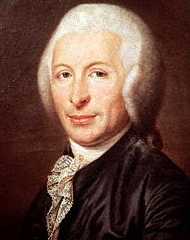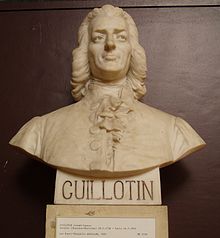Joseph-Ignace Guillotin
Joseph-Ignace Guillotin (born May 28, 1738 in Saintes , † March 26, 1814 in Paris ) was a French doctor and politician. The execution machine guillotine was named after him.
Life
Joseph-Ignace Guillotin was born as the ninth of 13 children of the lawyer Joseph-Alexandre Guillotin and his wife Catherine-Agathe Martin in Saintes in what was then the Charente-Inférieure department . After seven years of theological studies with the Jesuits at the Jesuit college in Saintes, where he proved to be an excellent pupil, and as a novice in Bordeaux , he left the order to study medicine in Reims from 1763 . He continued his studies at the Sorbonne in Paris in 1768, where he also obtained a doctorate on October 26, 1770 and shortly thereafter a license to teach as doctor regens .
Between 1778 and 1783 he taught anatomy , physiology and pathology at the Medical Faculty of the Paris University . In addition, in his free time he went to Masonic lodges , whose liberal ideas fascinated him, and even became a founding member of the Grand Orient de France . Guillotin also held the post of lodge master of the Masonic lodge La Concorde Fraternelle and was a member of one of the most famous lodges of the Enlightenment Neuf Sœur .
His prominent acquaintances included the Enlightenmentists Voltaire , Condorcet and the natural scientists Buffon and Lacépède .
Career and political interest
In 1784 he became a member of the royal commission that examined Franz Anton Mesmer's doctrine of animal magnetism and condemned it as unethical (The five-person commission that prepared the scientific report on animal magnetism as a remedy also included the chemist Lavoisier and the natural scientist Benjamin Franklin as well Jean-Sylvain Bailly at). For a year he also worked as the personal physician of the Count of Provence, who later became King Louis XVIII. and brother of Louis XVI. At the age of 49 he married Elise Saugrain.
He showed a keen interest in the political events of the day in France. In 1788, he and others demanded in a petition that the number of representatives of the third estate should be doubled and that freedom of the press should be granted. The king reacted indignantly and the publication was banned publicly.
French Revolution and the death penalty
On May 15, 1789 he was elected together with Emmanuel Joseph Sieyès and Jean-Sylvain Bailly to a member of the Assemblée Constituante , whose secretary he was from June 1789 to October 1791. When Louis XVI. closed their meeting place, the Hôtel des Menus Plaisirs, under a pretext, at Guillotin's suggestion, the participants gathered at the Jeu de Paume , where the famous ballroom oath was held.
The problem of the death penalty was extremely topical then. In a consultative session on the new penal code and penal system on December 1, 1789, Guillotin invoked and demanded the declaration of human and civil rights (as he had already proposed on October 10, 1789, along with other measures for the criminal implementation of equality in six articles) that for certain offenses without regard to the status the delinquents should be punished immediately, namely by beheading by means of the installation of a simple mechanism. His declared aim was to "humanize" the executions and to shorten the suffering of those executed. Previously, nobles and wealthy people were usually judged with the sword , heretics burned at the stake , state criminals quartered , thieves hanged and counterfeiters boiled alive in a cauldron. At first, Guillotin's proposal received little attention. Louis-Michel Le Peletier even made a major plea in 1791 for the abolition of the death penalty and a. supported by Mirabeau , Brissot and Robespierre . The demand for suspension of the death penalty could not be enforced in the end, and so it was agreed that the perpetrators should be beheaded regardless of their status or offense.
The guillotine
The executioner of Paris, Charles Henri Sanson , urged an early solution to alleviate the suffering of those to be executed. So they turned to the professor of surgery and personal physician of the king, Antoine Louis , to design such a killing instrument à la guillotin. He knew the problem addressed by Sanson and immediately set about working out a corresponding solution. On March 17, 1792, Louis presented his design based on the guillotine from Halifax . On March 20, 1792, a law was passed which ordered the use of the death penalty in France solely by means of such a machine.
The guillotine was therefore not an invention of the French Revolution , but a modern development of past execution devices , as they had already been used in Italy , Scotland , England and Germany . Following the guidance of Guillotin and under the supervision of Sanson, a prototype was developed by the German craftsman and harpsichord maker Tobias Schmidt , whose workshop in Paris was in the immediate vicinity of the residence of Georges Danton and Camille Desmoulins .
Count Pierre-Louis Roederer then received the order to have the machine built. The first experiments were carried out on live sheep . On April 15, 1792, three human corpses were beheaded for the first time in front of members of the Assemblée Constituante and the doctors Pierre-Jean-Georges Cabanis , Philippe Pinel , Cullerier, Antoine Louis and Guillotin. The crescent-shaped guillotine was found to be defective by Louis and was then replaced by a beveled edge. The first public execution using the guillotine took place on April 25, 1792. The condemned man was named Nicolas Jacques Pelletier and had been convicted of stealing the wallet of a passer-by with the use of a stick. In the end, the gawking crowd is said to have shown disappointment at the unusually rapid pace of the execution and demanded in a mocking song that the familiar wooden gallows be returned to her: "Rends-moi ma potence en bois, / Rends-moi ma potence!" Nevertheless, the machine still had numerous technical defects in detail, which is why its builder Schmidt did not receive a patent from the Minister of the Interior. The machine was popularly named "Louison" or "Louisette" after the king's personal physician. It was not until the royalist newspaper Actes des Apôtres that the name was renamed “Guillotine”.
Some friends of guillotin were supposed to become victims of his "humanitarian" machine themselves during the phase of the reign of terror . In 1794 Guillotin worked in a military hospital in Arras . As a member of the Assemblée Constituante, Antoine François de Fourcroy , Jean Paul Marat's successor , took up many of Guillotin's proposals for reforming medical education in the health sector. In 1795, Guillotin was imprisoned for a month because he was suspected of withholding information about the whereabouts of the family of Count Méré, who was sentenced to death.
Propagation of the smallpox vaccination
When he was released, Guillotin continued his medical research and in 1799, along with Pinel, became a passionate advocate of the vaccination against cowpox , which was promoted by the Englishman Edward Jenner . In 1800 he was appointed President of the Society against Cowpox. Many regional schools and regiments could be obliged to vaccinate, although there were many conservative clerical votes against these "obscure" English innovations. Through the mediation of Joséphine de Beauharnais , Guillotin was even allowed to go to Napoleon Bonaparte on this matter in 1803 to convince him of the benefits of such a vaccination. An audience with Pope Pius VII gave his endeavors an additional boost, as the spiritual leader of the Catholic Church promised to work for the new discovery among all of Christendom.
Guillotin also became the founder of a medical academy in Paris whose task it was to deal with all aspects of public hygiene .
Guillotin's theses on medical innovations of his time
Guillotin saw the method of trying to cure morphinists with substitutes as reprehensible. He regarded the quarantine to prevent the introduction of cholera epidemics as useless and costly. For him, cremation had no major hygienic advantages over the previous method of burial.
On March 26, 1814, Joseph-Ignace Guillotin died of a carbuncle in his left shoulder at the age of 75 in Paris and was buried in the Père Lachaise cemetery.
After his death, Guillotin's family asked to change the name of the execution machine. After the government refused, his family members changed their family names.
Quotes
"The guillotine is a machine that removes the head in the twinkling of an eye and lets the victim feel nothing but a feeling of refreshing coolness."
Publications
- An vesiculae felleae per ductum cysticum bilis mittatur? Praeses Thoma Levacher de la Feutrie . Paris: typis Quillan, 1768
- An ossa prope articulum post colli genesin leni motu exercenda? Praeses Theophilus de Borden. Paris: typis Quillan, 1770
- An praegnantibus, parturientibus et puerperis, nulla aut saltem non nisi lenientia remedia danda? Praeses Marianus Jacobus Clarus Robert. Paris: typis Quillan, 1770
- Pétition des citoyens domiciliés à Paris, on 8 December 1788 . Paris: chez Clousier, imprimeur du Roi, & des Six-corps, 1788 ( digitized )
- Le Grand spécifique, ou L'ordonnance de MM. Guillotin et Salle, docteurs en médecine, sur la maladie et le traitement de très-haut et très-puissant seigneur, monseigneur, le haut clergé de l'église gallicane , 1790s ( Digitized )
- Compte rendu et rapport présentés à l'Assemblée nationale par les commissaires de la salle . Paris: Impr. Nationale, 1791 (August 30)
literature
- Daniel Arasse : The guillotine. The power of the machine and the spectacle of justice. Rowohlt, Reinbek near Hamburg 1988 ISBN 3-499-55496-8 .
- Daniel Gerould: Guillotine. Its legend and lore. Blast Books, New York 1992, ISBN 0-922233-02-0 .
- Alister Kershaw: A history of the guillotine. Calder, London 1958.
- Georg Korn: Joseph-Ignace Guillotin (1738-1814). A contribution to the history of medicine and the medical status. Medical dissertation (Friedrich-Wilhelms-Universität) Berlin, Gustav Schade printing house, Berlin 1891.
- Henri Pigaillem: Le docteur Guillotin. Bienfaiteur de l'humanité. Pygmalion, Paris 2004. ISBN 2-85704-943-9 .
- André Soubiran: Ce bon docteur Guillotin et sa “simple mécanique” d'après les documents de Pierre Mariel. Librairie académique Perrin, Paris 1962.
Web links
Individual evidence
- ^ Georg Korn: Joseph-Ignace Guillotin (1738-1814). A contribution to the history of medicine and the medical status. 1891, p. 11.
- ↑ Georg Korn (1891), pp. 18-20.
- ↑ Georg Korn (1891), p. 31.
| personal data | |
|---|---|
| SURNAME | Guillotin, Joseph-Ignace |
| BRIEF DESCRIPTION | French doctor and politician |
| DATE OF BIRTH | May 28, 1738 |
| PLACE OF BIRTH | Saintes |
| DATE OF DEATH | March 26, 1814 |
| Place of death | Paris |



